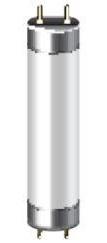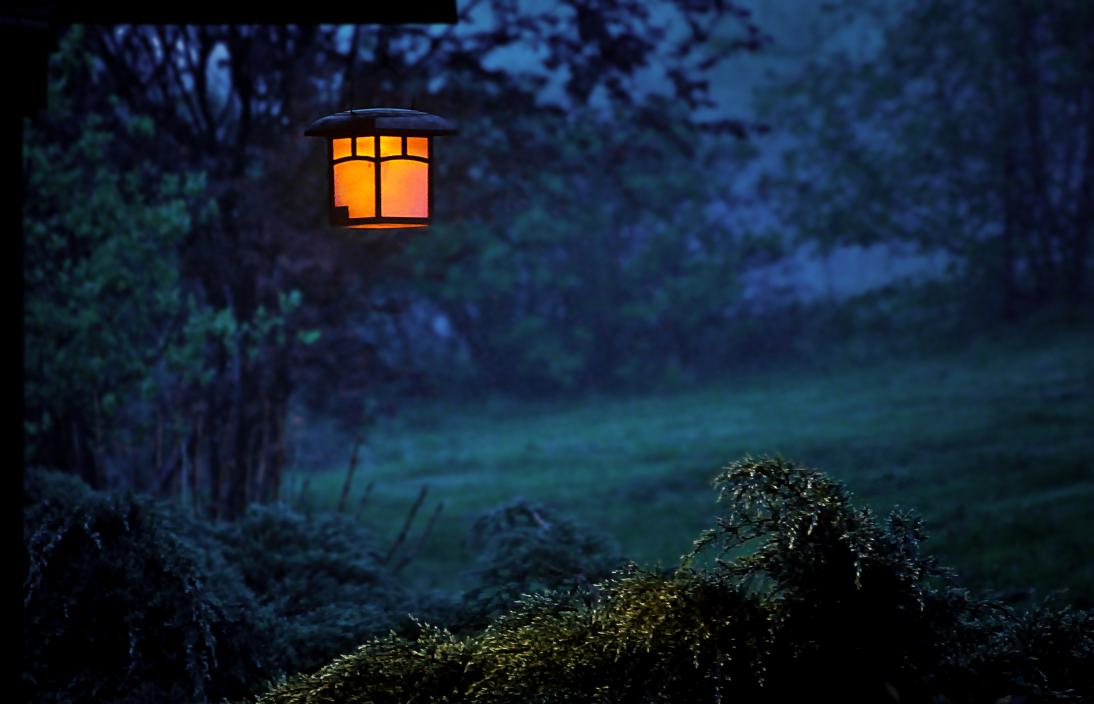You will acquire basic knowledge about color physics.
INTRODUCTION
A basic knowledge of color physics is an important basis for the complete color process. In particular, understanding color perception and color representations is an important prerequisite for working with colors.
BASIC COLOR THEORY
HOW ARE DIFFERENT COLORS PRODUCED?
PRIMARY COLORS
The three colors blue, red and yellow are termed primary colors. Their most important characteristic is that these colors are not produced by mixing other colors.
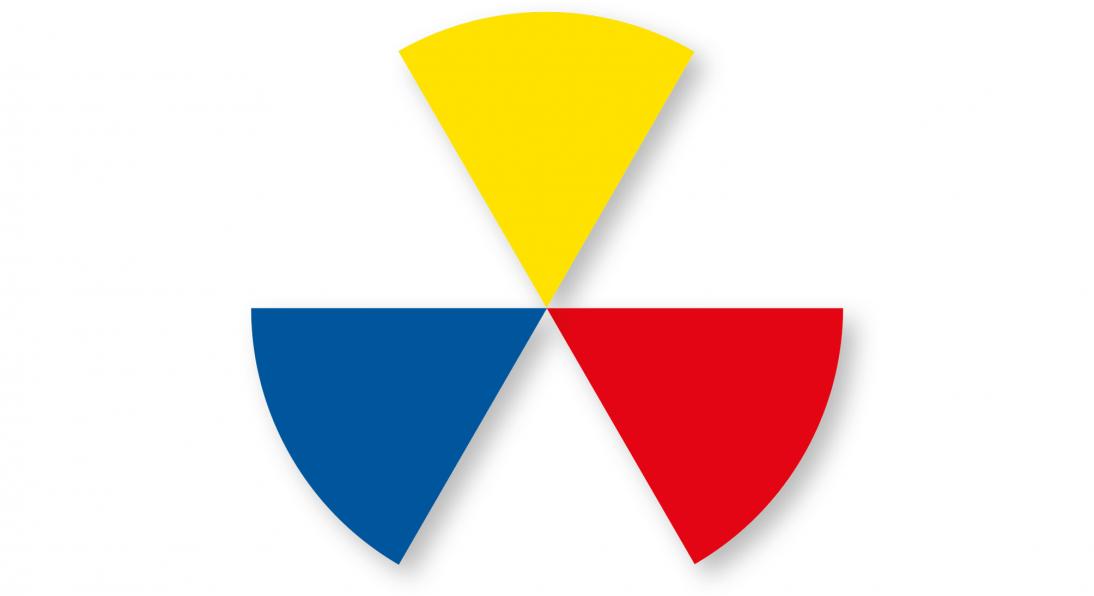
The three primary colors
SECONDARY COLORS
Secondary colors are created by mixing two primary colors. Mixing two primary colors produces a second-order color, which is termed a “secondary color”. Thus, three more colors are created: orange (by mixing red and yellow), violet (by mixing red and blue), and green (by mixing blue and yellow). The results can vary depending on how much of each primary color is added.
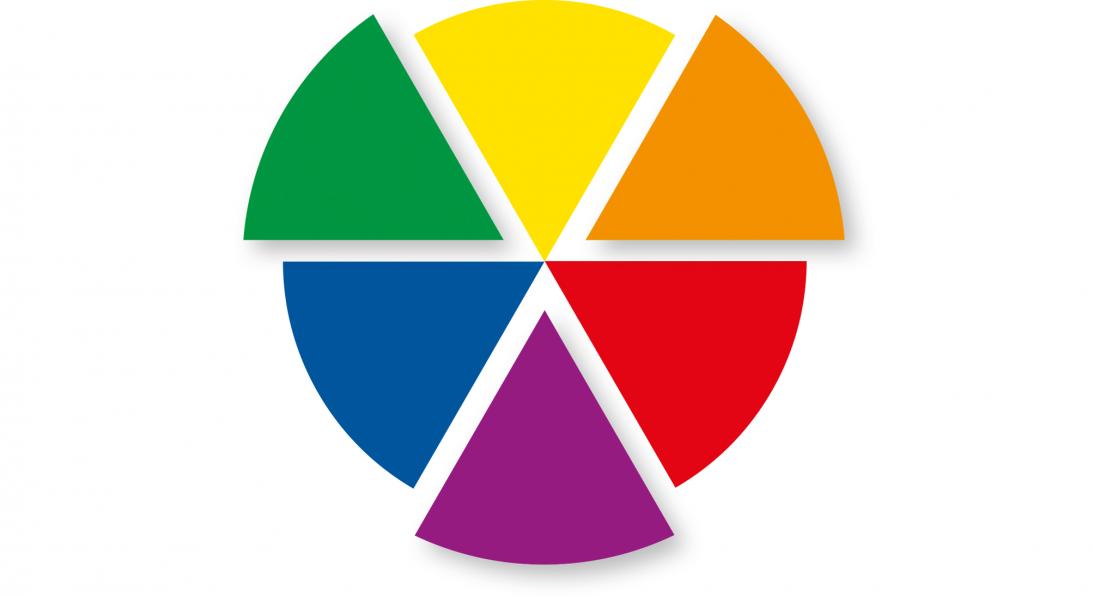
The three secondary colors
TERTIARY COLORS
Tertiary colors are combinations of primary and secondary colors. There are six tertiary colors; red-orange, red-violet, yellow-orange, yellow-green, blue-green and blue-violet. An easy way to remember these names is to place the primary name before the other color. The color wheel contains only the pure colors (primary and secondary colors). Tertiary colors, as well as black and white, are not part of the color wheel.
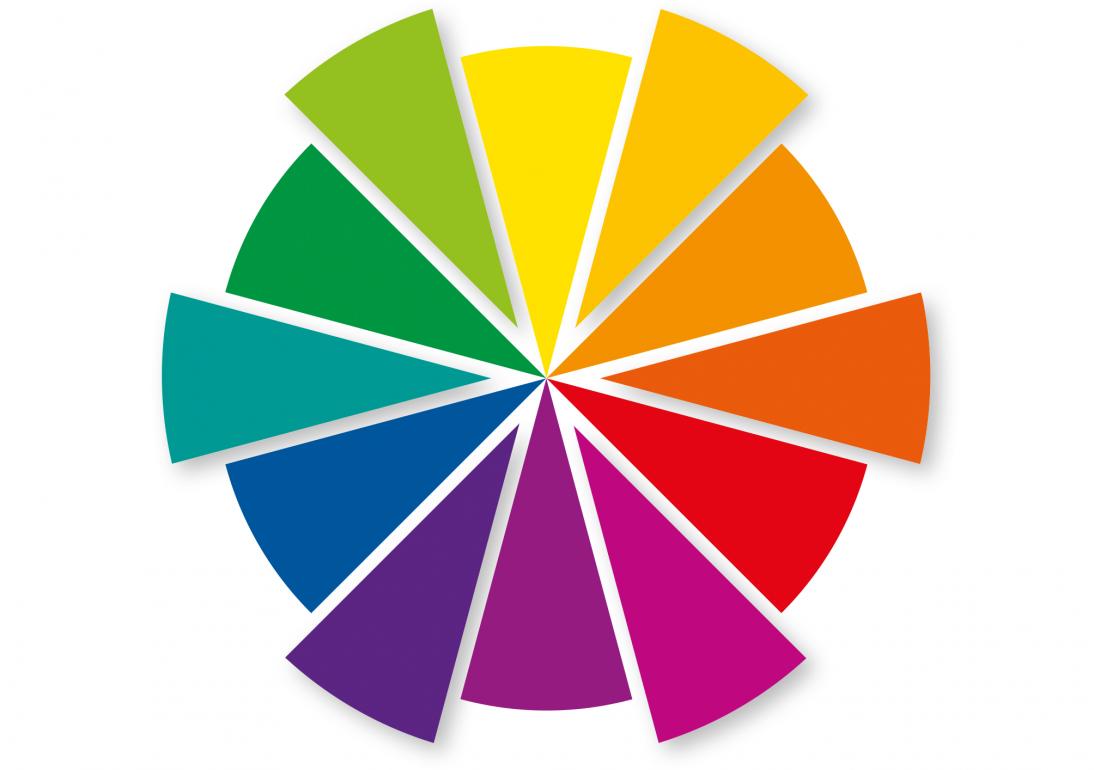
The six tertiary colors
The color wheel is divided into warm and cold zones. The warm colors are at the top, and the cold ones are at the bottom. Green can also be regarded as one of the warm colors if it is a yellowish-green.
Tertiary colors contain elements of all three primary colors. For this reason, all tertiary colors are broken colors, i.e., their purity and chromaticity are reduced. Tertiary colors include the large range of brown tones. When it comes to tertiary colors, the human eye can distinguish between more than 100,000 colors (with secondary colors the number is only approx. 160 shades). In nature too, the tertiary colors are the most commonly occurring colors.
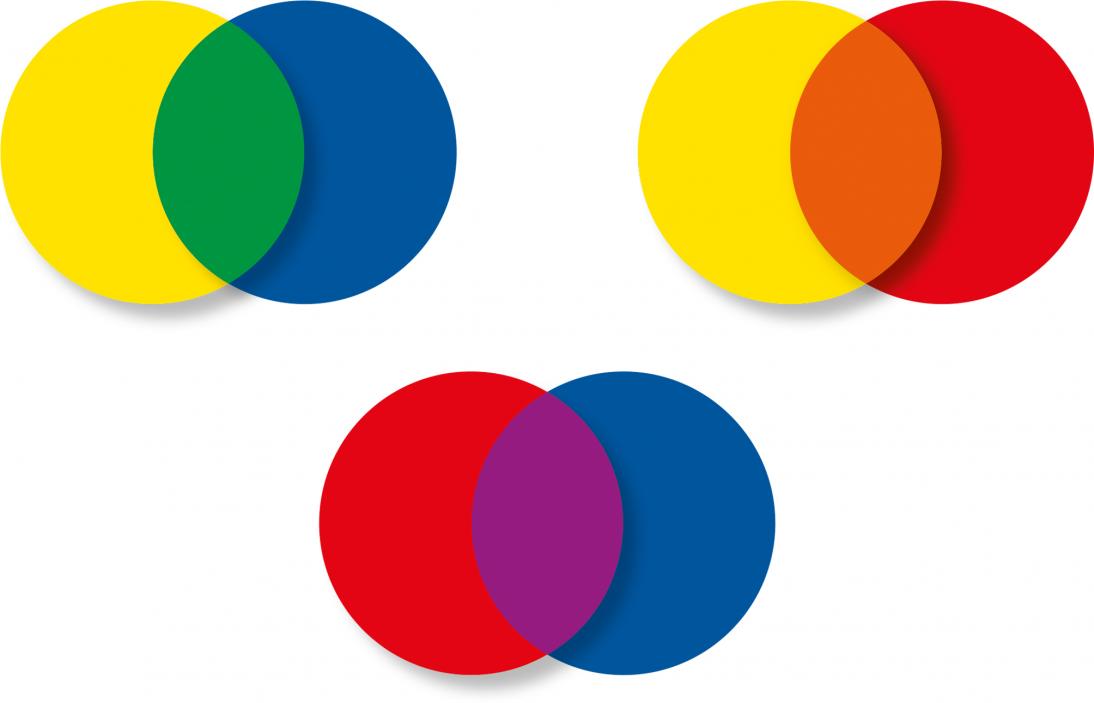
Example of color compositions
COMPLEMENTARY COLORS
Complementary colors are opposite each other on the color wheel and always consists of a primary color and a secondary color. When placed next to each other, they appear to become brighter, but if mixed together, they produce black in the subtractive color system.

Representation of complementary colors using the color wheel
SUBTRACTIVE COLOR MIXING
Subtractive primary colors are colors that are associated with reflected light. In this case the subtractive colors are blue, red and yellow.
When equal amounts of red, blue and yellow pigment in paint are combined, black is produced. When the colors are combined to produce black, we refer to them as subtractive colors.
All visible colors can be mixed (with white to lighten them and black to darken them). If yellow, red and blue surface colors are mixed in equal proportions, the result is grayish brown to black.
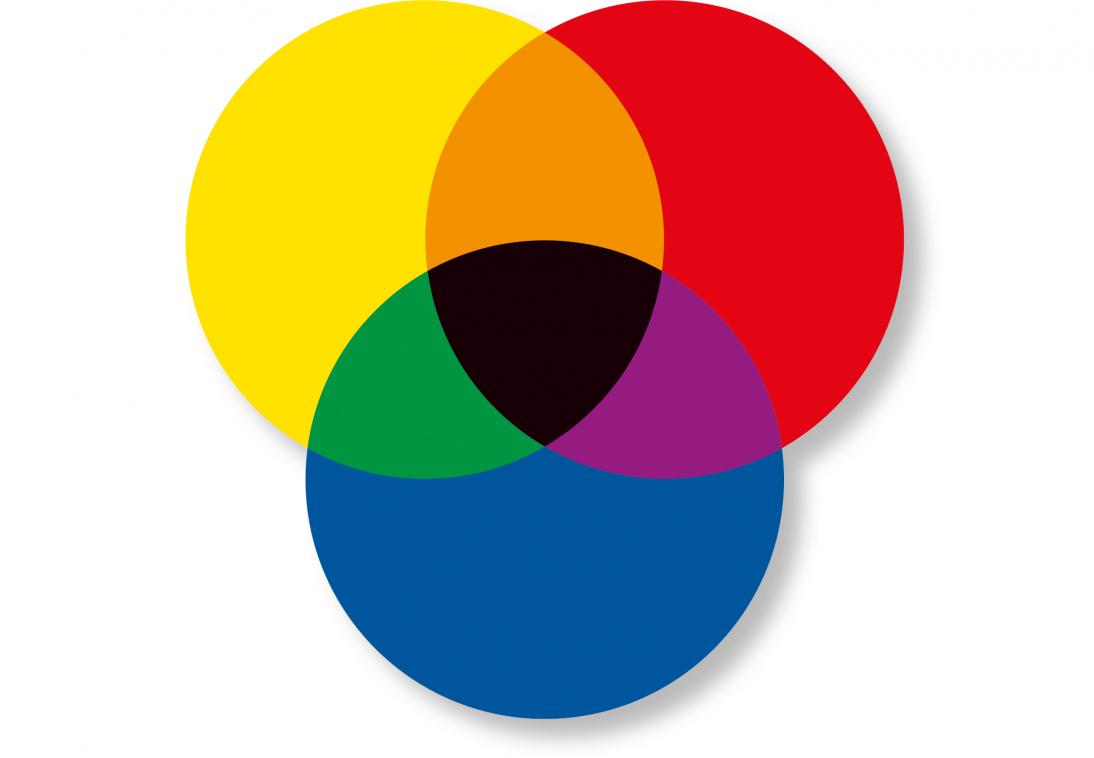
Representation of subtractive color mixing
ADDITIVE COLOR MIXING
Additive colors are colors that are associated with emitted light directly from a source before an object reflects the light. These colors are red, green and blue. Red, green and blue are the primary colors of white light. When equal amounts of red, green and blue are combined they produce white light. When the colors are combined to produce white, we call these additive colors.
Conclusion:
Additive primary colors are used to mix the colors of light with each other, while subtractive primary colors are used to mix printing inks or dyes.
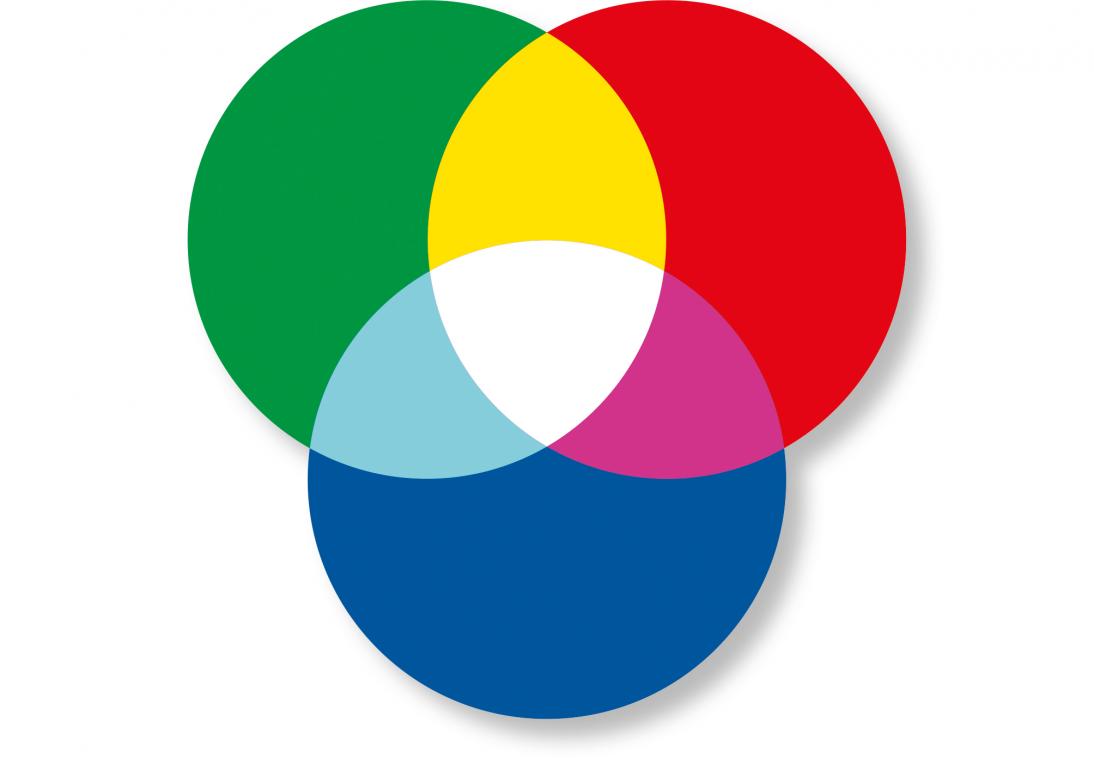
Three lights with red, blue and green light, respectively, are shone on a bright surface in a very dark room.
HOW DO WE PERCEIVE COLORS?
THE VIEWING PROCESS
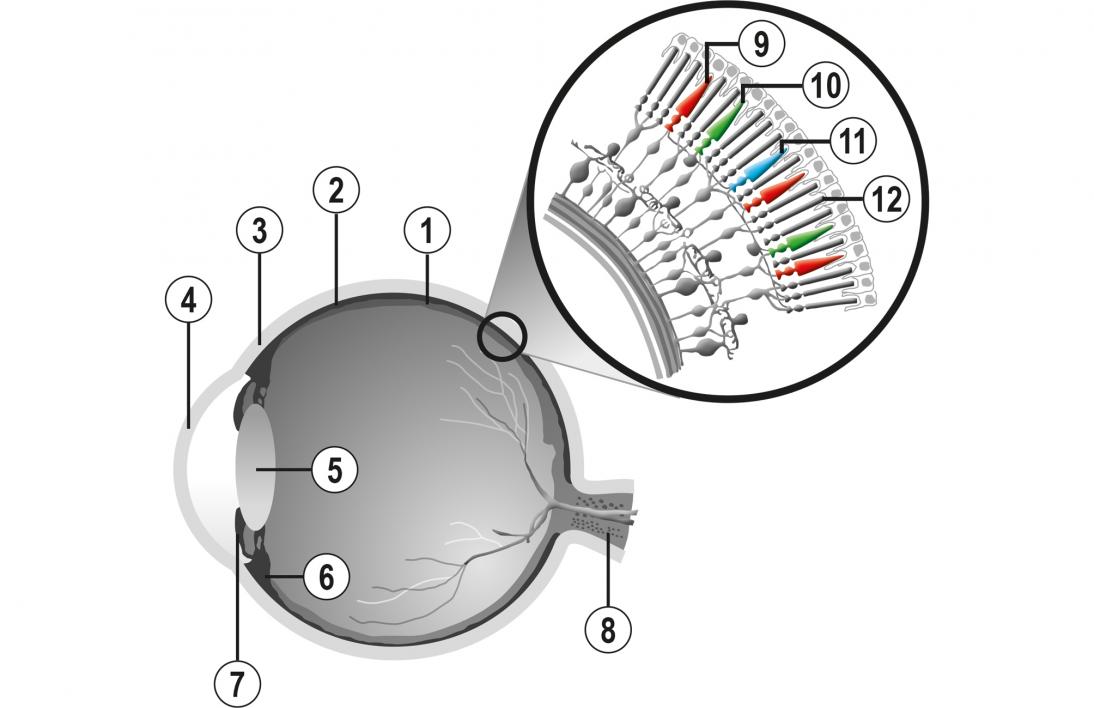
The human eye; (1) Retina, (2) Chorid, (3) Sclera, (4) Cornea, (5) Pupil, (6) Ciliary body, (7) Iris, (8) Optic nerve, (9) Long-wave cone, (10) Middle-wave cone, (11) Short-wave cone, (12) Rods
- Cornea: protects the eye
- Pupil: regulates the amount of light entering the eye
- Lens: focuses the light rays on the macula lutea (acute vision)
- Optic nerve: sends signals to the brain
Rods are more numerous and are more sensitive than the cones. However, they are not sensitive to color.
Cones are responsible for the eye's color sensitivity and can be divided into "red" cones (64%), "green" cones (32%), and "blue" cones (2%) based on measured response curves.
The wavelength of light:
COLOR is perceived through LIGHT. The sensation of color comes from its reactions to the WAVELENGTH of the lights emitted or reflected by the objects. Color is not in objects but in our perception.
A combination of physics and physiology

Color perception using the example of a green leaf
CHEMICAL TRANSFORMATIONS:
A membrane in the back of the eye sensitive to light, the retina, performs the chemical process of vision. The retina contains many light receivers, rods and cones, tiny photo receptor cells specialized in detecting the wavelengths coming from the environment. They use the energy that the light transfers to them to reach the energy levels necessary to react to the light stimulus.
These vision cells collect the different parts of the spectrum of sunlight and transform them into electrochemical impulses, which are sent to the brain through the optic nerve. They are responsible for creating the sensation of color. The retina behaves like a complex laboratory or central electrochemical that transforms and produces energies, receives signals, transforms them, codes them and transmits them to the brain for its interpretation.
It is in the brain where all information is processed and the signals are reconstructed, forming images that are identifiable to the outside world, complementing here the act of vision with the no less complex point of perception.
LIGHT AND COLOR
Our visual system is able to locate and interpret certain characteristics of light phenomena: their intensity, their wavelength and the spatial distribution of light. The INTENSITY of light: perception of luminosity. The sensation of luminosity comes from the reactions of the visual system to the luminance of objects. Luminous flux is the total amount of light energy emitted or reflected by an object. It is measured in lumens (lm.) Light bodies: emit light
---> the sun, a candle, an electric light Illuminated bodies: reflect light
---> All other objects that are not bright.
The color of objects: The objects reflect only some of the wavelengths of light, so that their color is the product of the visual mixing of the colors of the wavelengths it reflects.
The color of a body is a product of the individual absorption capacity of the material of which it is made and of the luminosity of the surrounding.
For example, a blue object absorbs all wavelengths of sunlight, except for the one corresponding to the blue color, which is reflected by the object and captured by the retina.
There is no color without light: “At night all cats are gray.”
THE SPECTRUM OF LIGHT
SPECTRUM
If white light emitted by a light source is directed through a prism, it is split into light rays of different colors, which are called “spectral colors” or, more `colloquially, “rainbow colors”. This is due to the fact that the light rays are refracted at different angles. These spectral colors have a frequency range of 380 to 780 nm.
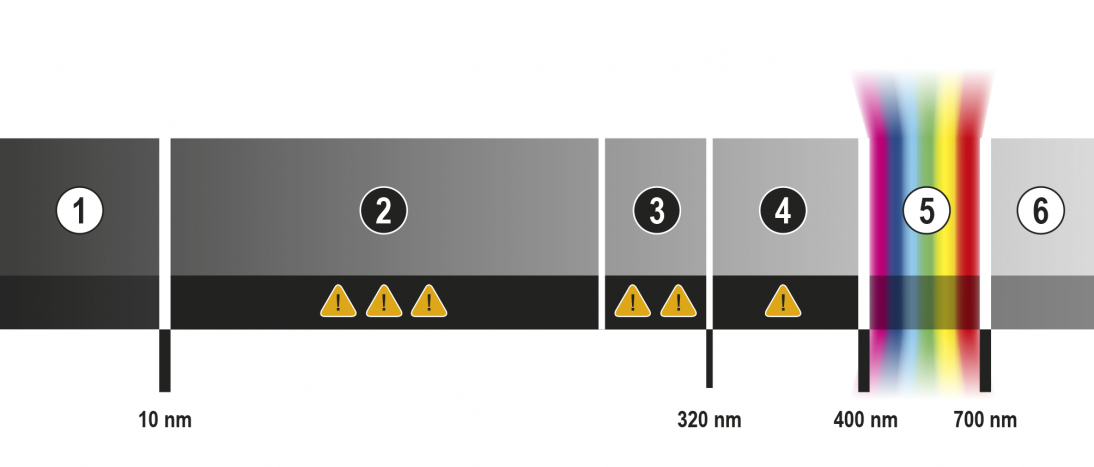
The wavelength range of spectral light is from 380 to 780 nanometres; (1) Gamma and X rays, (2) UV-C, (3) UV-B, (4) UV-A, (5) Light, (6) Infrared rays
WHITE LIGHT AND COLOR VISION
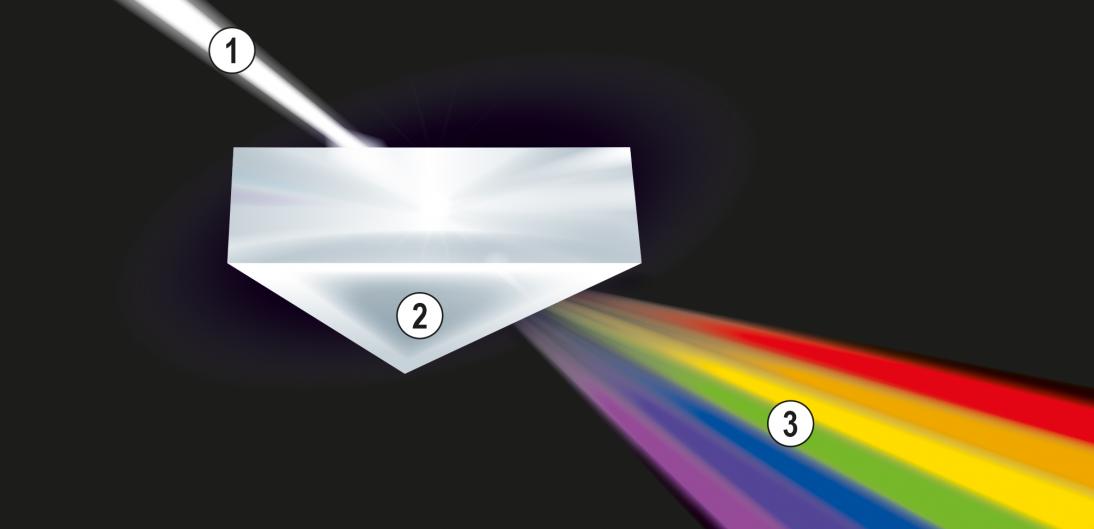
Prismatic spectrum of white light; (1) White light, (2) Prism, (3) Visible spectrum
The idealised prismatic spectrum of white light is composed of six colors.
- violet
- blue
- green
- yellow
- orange
- red
ABSORPTION AND REFLECTION
-
Absorption
If white light illuminates a colored object, it will absorb all of the light rays of the spectrum except those that correspond to its body colors. A green leaf appears to be red because it absorbs all light rays except those that are green. The absorbed radiation is turned into heat.
-
Reflection
The green-light rays are reflected to reach and excite our eyes.
-
Transmission
Light rays that fall through a transparent object without being affected in any way.

Example of color reflection
THE INFLUENCE OF THE COLOR AND INTENSITY OF LIGHT
Depending on the light source, there are different colors and different intensities of light. We distinguish four major categories:
|
Daylight (D65) |
Fluorescent tube light (TL84) |
|
Incandescent light bulb (A) |
Sodium Vapor lamp |
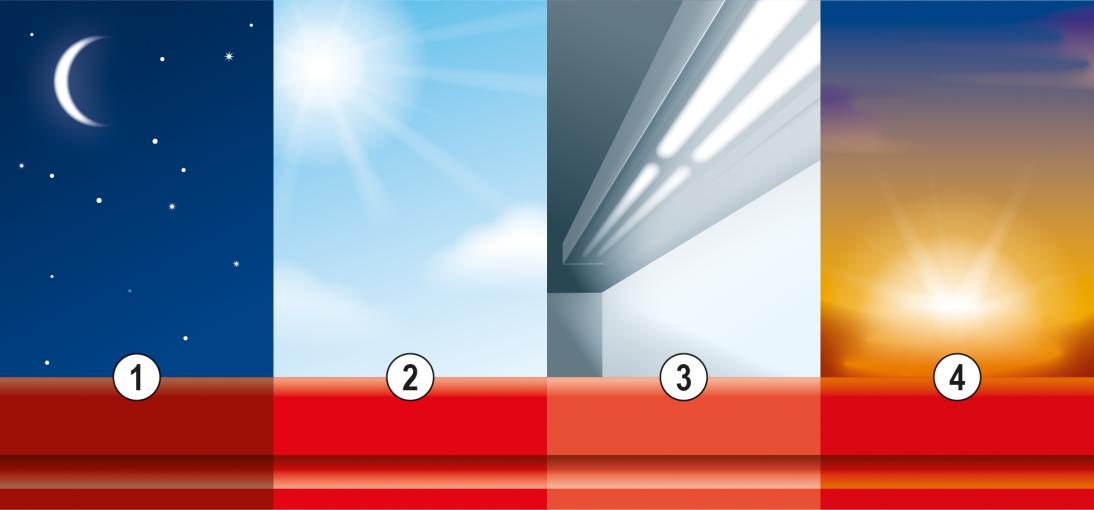
Influence of light on color perception; (1) Night, (2) Noon, (3) Fluorescent, (4) Sunset
The intensity of light (measured in candela, cd) also has a major impact on color vision.
Various light sources and standardized light types for evaluating colors:
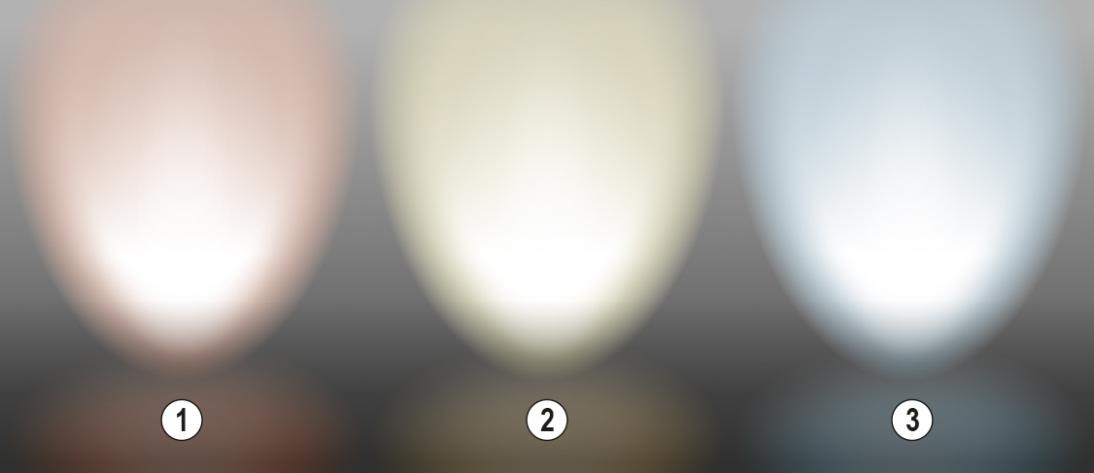
Various light sources and standardized light types for evaluating color; (1) 3000K - Warm white, (2) 4000K - Cool white, (3) 6500K - Daylight
CONTRAST
SIMULTANEOUS CONTRAST
The simultaneous effect of colors can reinforce the color contrasts and increase saturation. Complementary colors seem stronger and more luminous when combined with each other.
The illustrations besides demonstrate simultaneous contrast. Concentrate your gaze on the "°" between the squares for a few seconds so that the squares are viewed “incidentally”:
You will see that the small mid-gray square against the white background looks darker than the one against the black background, even though they have the same gray tone.

Example of simultaneous contrast
When concentrating on the "°" this time, we see that the red on the left seems more intense. However, turquoise and orange have the same amount of lightness, so this is not the same effect of increased contrast as with the black/white experiment. This new effect in which colors can enhance each other is referred to as "complementary contrast" or "simultaneous contrast".
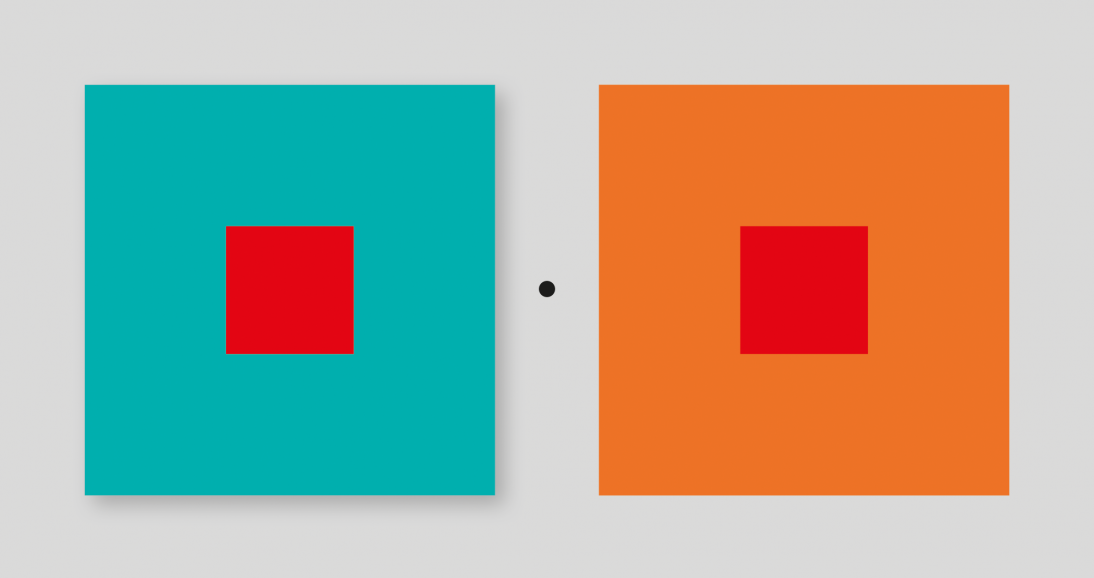
Example of simultaneous contrast
SUCCESSIVE CONTRAST
After concentrating intensely on color fields we can still “see” an afterimage of these even once the stimulus itself has been removed, for instance, when you close your eyes. For this reason, contrasts that cause such an afterimage are known as successive contrast (successive = one event occurs after the other). Successive contrast is a purely physiological corrective process by the body’s vision system, in other words, it is a biological, physiological issue. It is a helpful means of explaining color effects and color phenomena, from an aesthetic viewpoint too.
After concentrating intensely on color fields we can still “see” an afterimage of these even once the stimulus itself has been removed, for instance, when you close your eyes. For this reason, contrasts that cause such an afterimage are known as successive contrast (successive = one event occurs after the other). Successive contrast is a purely physiological corrective process by the body’s vision system, in other words, it is a biological, physiological issue. It is a helpful means of explaining color effects and color phenomena, from an aesthetic viewpoint too.
If a person looks at a color field for an extended period and then turns his or her eye onto a field of a different color or closes his or her eye, a complementary afterimage of the colored field first looked at appears. The shape of the field remains the same, but the colors, and thus the levels of lightness, change as follows:
RED BECOMES GREEN - GREEN BECOMES RED (COMPLEMENTARY COLORS)
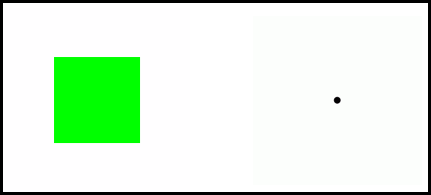
Example of successive contrast
Look at the green square with one eye from a distance of approx. 15 cm. Close or cover the other eye. After approx. 20 seconds, look at the adjacent field. To aid orientation, the center is marked with a small dot. You will now see a reddish-pink square in the middle of the square surface that gradually fades.
When the eye looks at a color field intensely for an extended period, the photoreceptor cells are uniformly stimulated for a longer period. The relevant substances in the photoreceptor cells are used up. Once the field of view changes, these substances are missing in precisely these cells, and the complementary afterimage is seen instead of the “normal” effect.
The afterimage is seen particularly well with pure, clearly defined colors, but successive contrast, and thus the afterimage, is also seen with dim, darkened or lightened colors, even if the effect is less marked.
METAMERISM
If two colors look the same in daylight, but have a different effect under a different light source (e.g., artificial light), this is known as metamerism.
We perceive the color differently when the light changes

Illustration of metamerism; (1) In the body shop light, (2) In daylight
EXAMPLE METAMERISM:

Technical representation of metamerism
Colors of the same spectral composition always look the same, irrespective of the lighting used. These are “absolutely identical” colors.
For automotive refinishing purposes, therefore, only pigments that are also used in the OEM paintline should be employed. The Glasurit mixing formulas have been appropriately developed and tested in the color lab under a wide range of lighting types.
In practice, however, additional tinting may be necessary. Wherever possible, only mixing bases specified in the mixing formula should be used.
For automotive refinishing, therefore, the following applies:
- Mix the color exactly as specified in the formula.
- Carry out tinting only with mixing bases contained in the formula.
- Stir the mixing bases well.
THE COLOR WHEEL AND COLOR SYSTEMS
THE COLOR WHEEL
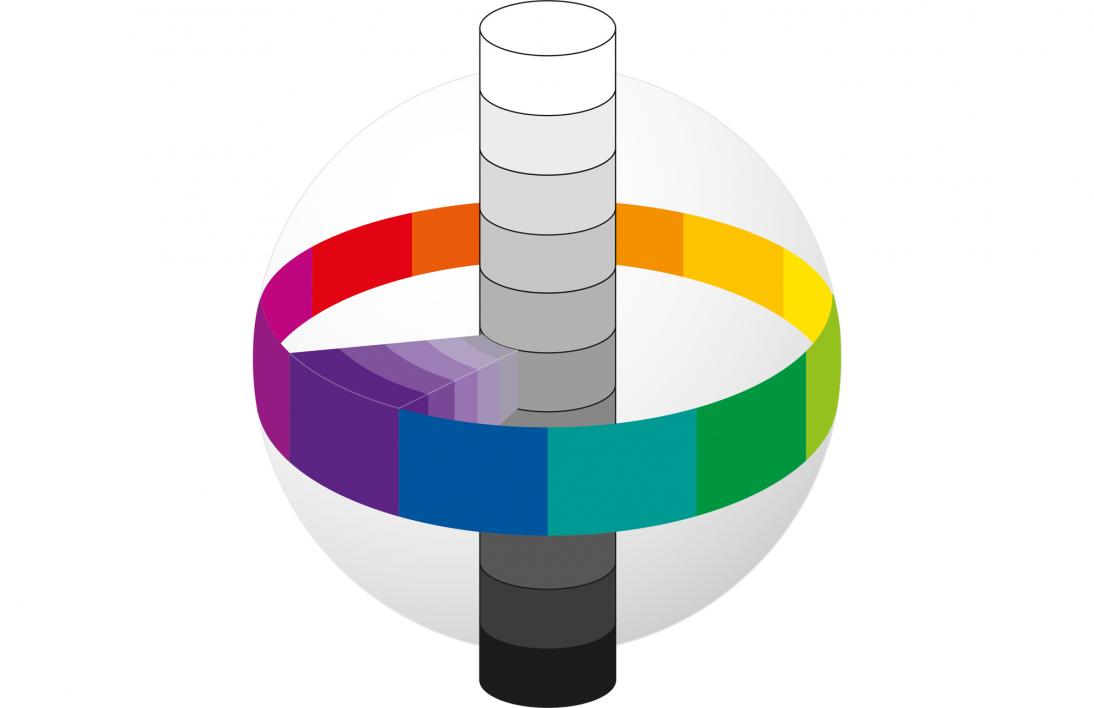
Color wheel
The color wheel contains the primary colors for additive color mixing and also the primary colors for subtractive color mixing.
COLOR SYSTEMS
Every color has its own clear appearance, based on three elements: hue, chroma and lightness. If you describe a color using these three attributes, you can define it precisely and distinguish it from others.
HUE
When people are asked to describe a color, they usually start by mentioning its hue. This specifies fundamentally how we perceive a color – red, orange, green, blue, etc.
CHROMA (SATURATION, PURITY)
Whether we perceive a color as mat and pale or powerful and striking depends on its chroma. Chroma describes the extent to which the color approaches gray or the pure hue. If, for example, you compare a tomato to a radish, the tomato appears to have a stronger color, while the red of the radish is weaker.
LIGHTNESS (BRIGHTNESS)
A further characteristic feature of a color is its lightness. A color can be described as light (bright) or dark (dim), by comparing lightness levels. If, for example, you place a tomato and a radish side by side, the tomato will generally look brighter. The radish has the lower lightness level.
THE MUNSELL COLOR SYSTEM
This color system is the original system used in the industry. In the Munsell color system all the colors are configured in the same axis in terms of their lightness and chroma.
The Munsell color system assigns numerical values to the three attributes of a color: hue, lightness and chroma. Adjacent color samples stand for distances in human visual sensation that are perceived as the same.
The distances between lightness and chroma are the same in terms of perception. For this reason the color system is not symmetrically structured but is similar to a tree.
THE RAL COLOR SYSTEM
The RAL color system is a compilation of standardized colors and is not tailored to any particular paint manufacturer. The original table consisted of 40 colors, though this was later expanded to 210 colors.


